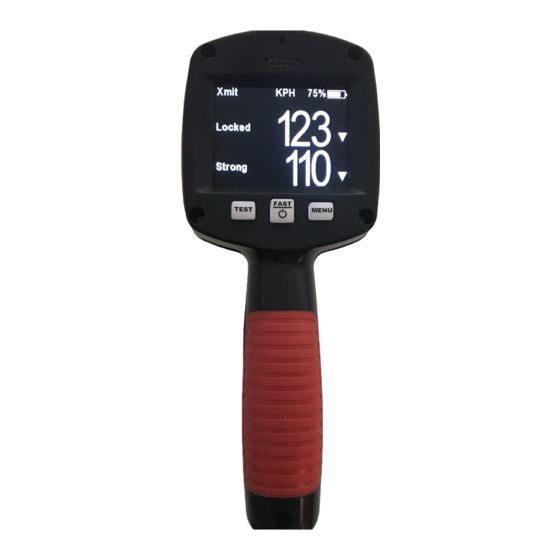Decatur Electronics Scout 2 Benutzerhandbuch - Seite 12
Blättern Sie online oder laden Sie pdf Benutzerhandbuch für Messgeräte Decatur Electronics Scout 2 herunter. Decatur Electronics Scout 2 19 Seiten.

The following table shows the effect that an increasing angle has on a displayed speed.
Small angles (less than 10°) have little effect on accuracy. As the angle increases, the displayed speed decreases. At
90° the radar reads the speed of the object as zero regardless of it's true speed.
Fan Interference
Fan interference is the most common form of interference that you are likely to experience. It is caused when the
radar measures the speed of the vehicle blower fan. Changing the fan speed causes a proportional change in the
display speed. To correct this, relocate the radar so it does not display spurious speeds or turn off the blower fan
motor.
Electromagnetic Interference (EMI)
Operating electric motors can produce EMI. EMI from power seats or windshield wipers can also produce spurious
target speeds. To correct the interference, simply turn off its source.
Feedback Interference
When the radar beam is directed at computer screens, streetlights, and other electronic devices, it can display
spurious speeds. To correct the interference, relocate the radar.
Multi-Path Beam Cancellation
If multi-path beam cancellation occurs, the target vehicle speed sporadically blinks and reappears at semi-random
intervals. This type of interference occurs when the radar loses track of a target vehicle because the target is
reflecting two or more signals, which are interfering with each other. The Scout 2 is immune from multi-path
cancellation.
Radio Frequency Interference (RFI)
The system can inadvertently process radio energy as Doppler speeds, including that from police radios, airport radar,
microwave transmission towers, CB radio transmitters, and AM/FM transmission towers. For this type of interference
to occur, the radar must be operating very close to the radio transmitter.
The Scout 2 radar contain an RFI detection circuit that detects excess radio frequency energy. When stray radio
frequency energy reaches an excessive level, the system displays an RFI message and stops processing and displaying
speeds. The system resumes normal operation when the RFI condition no longer exists. At that time, any locked
speeds will display again.
0°
1°
3°
Actual
Speed
50 km/h
50
49
49
65 km/h
65
64
64
80 km/h
80
79
79
90 km/h
90
89
89
100 km/h 100
99
99
110 km/h 110 109 109 109 108 106 103 95
Actual and displayed speeds at antenna-to-target angles
Horizontal Angle Degrees
5°
10°
15°
20° 30° 45° 60° 90°
Displayed speed:
49
49
48
46
43
64
64
62
61
56
79
79
77
74
69
89
88
86
84
77
99
98
96
93
86
35
25
0
45
32
0
56
40
0
63
45
0
70
50
0
77
55
0
12
